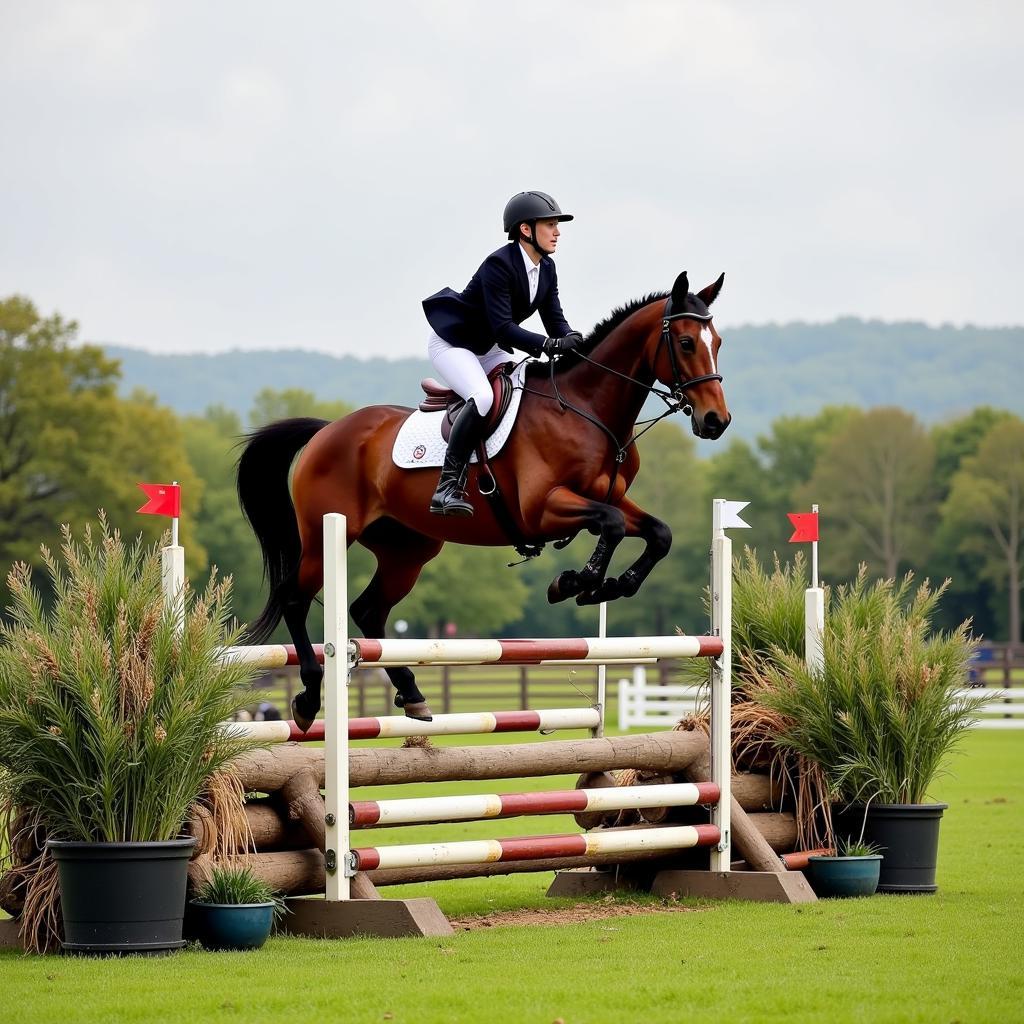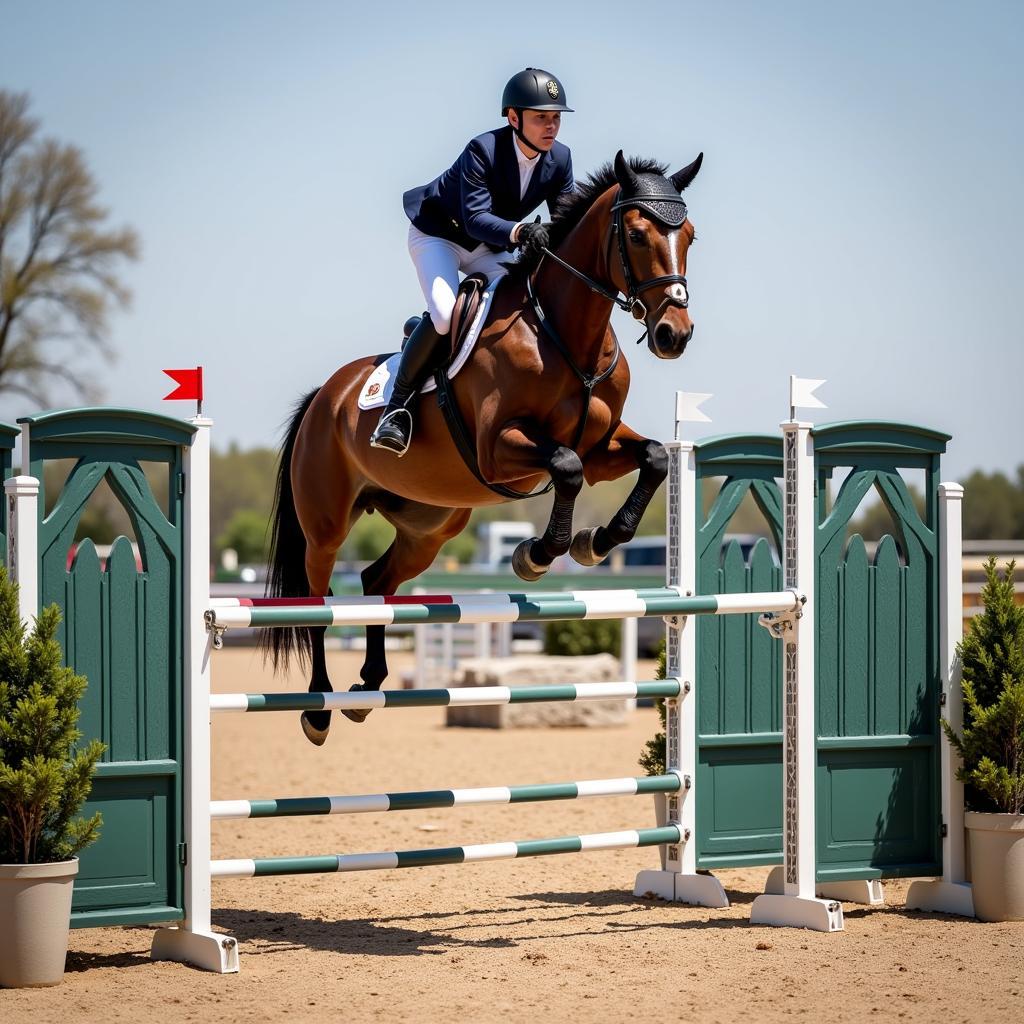Horse Jumping Standards are a crucial aspect of equestrian sports, defining the height and complexity of jumps in competitions and training. Understanding these standards is vital for riders of all levels, ensuring safety, progress, and fair competition. From beginner cross rails to the challenging Grand Prix heights, navigating the world of horse jumping standards can seem daunting. This guide provides a comprehensive overview of everything you need to know.
Decoding the Different Horse Jumping Standards
Horse jumping standards vary based on the discipline and level of competition. Key factors include the height of the vertical obstacles, the width of oxers (spread jumps), and the complexity of combinations. Let’s explore the typical standards seen in common equestrian disciplines:
-
Hunter Classes: These classes emphasize the horse’s style, grace, and smooth, flowing movement over fences. Heights generally range from 2’6″ to 4′ for adults, with lower heights for junior riders. Hunter courses often feature natural-looking obstacles like logs and brush.
-
Jumper Classes: Focused on speed and clear rounds, jumper classes present more technical challenges. Heights can reach upwards of 5′ or more in Grand Prix competitions, with complex combinations and tight turns demanding precision from both horse and rider.
-
Eventing: This multifaceted discipline combines dressage, cross-country, and show jumping. Show jumping phases in eventing adhere to similar standards as regular jumper classes, but the height and complexity vary with the event’s level.
 Hunter Class Horse Jumping Standards
Hunter Class Horse Jumping Standards
- Equitation Classes: These classes primarily judge the rider’s position, control, and effectiveness. Jump heights are typically lower than in hunter or jumper classes, allowing judges to focus on the rider’s technique and ability to guide the horse effectively through the course.
After covering the various disciplines, let’s delve into how these standards translate to different experience levels. For instance, a beginner might start with cross rails or small verticals, progressing to higher fences as their skills develop. Conversely, more advanced riders tackle challenging combinations and greater heights, pushing the boundaries of their abilities and the horse’s athleticism.
 Grand Prix Horse Jumping Standards
Grand Prix Horse Jumping Standards
What Influences Horse Jumping Standards?
Several factors contribute to setting horse jumping standards. The horse’s age and experience level, the rider’s skill, and the specific goals of the competition all play a role. Additionally, safety is paramount, and standards are designed to minimize risk while still challenging horse and rider.
How to Prepare for Different Jumping Heights
Preparing for specific jumping heights requires consistent training and a progressive approach. Gradually increasing the height and complexity of jumps allows the horse to develop strength, coordination, and confidence. Regularly practicing with a qualified trainer is crucial to ensure proper technique and safe progression.
Key Considerations for Riders
Understanding horse jumping standards is not just about knowing the heights. It also involves recognizing the technical aspects of each jump, such as approach angles, distances, and the type of obstacle. Knowing the [menlo horse show] schedule can be helpful for riders looking for competitive opportunities.
How are Horse Jumping Standards Measured?
Jumping standards are measured from the highest point of the obstacle to the ground. This ensures consistency and fair competition across different venues and events. For spread jumps (oxers), the width is also measured to determine the overall difficulty. Riders interested in a specific breed, such as the [confederation horse], should familiarize themselves with the breed’s typical jumping abilities.
 Measuring Horse Jumping Standards
Measuring Horse Jumping Standards
Conclusion
Mastering horse jumping standards is a continuous journey for any equestrian. By understanding the different levels, influences, and preparation required, riders can set realistic goals, improve their skills, and enjoy the thrill of this challenging sport. Remember, consistent training, a focus on safety, and a deep understanding of these standards are key to success in the world of horse jumping. If you’re in Boulder and looking to refine your riding skills, you might consider checking out some [horse riding lessons boulder]. Perhaps you are more interested in attending horse shows like the [j bar j horse show].
FAQ
-
What is the highest horse jumping standard? The highest jumps typically seen are in Grand Prix competitions, often exceeding 5′.
-
How do I progress through the different jumping standards? Consistent training and gradually increasing jump heights under the guidance of a qualified instructor is crucial.
-
Why are horse jumping standards important? They ensure fair competition, promote safety, and facilitate progressive training.
-
Are horse jumping standards the same across all disciplines? No, they vary depending on the discipline, such as hunter, jumper, or eventing.
-
How are spread jumps measured? Both the height and width are measured to determine the difficulty.
-
What resources can I use to learn more about horse jumping standards? Contacting your local equestrian federation or consulting with experienced trainers can provide valuable insights.
-
How do I find appropriate competitions for my current jumping level? Researching local and national horse show schedules will help you identify suitable events.
Horse Jumping Standards Table
| Level | Height (approx.) | Type of Jumps |
|---|---|---|
| Beginner | Cross rails – 2′ | Cross rails, small verticals |
| Intermediate | 2’6″ – 3’6″ | Verticals, oxers, small combinations |
| Advanced | 4′ – 5’+ | Larger oxers, complex combinations, triple bars |
Common Scenarios
- Scenario 1: A young rider is moving up from cross rails. They should focus on maintaining correct form and building confidence over gradually increasing vertical jumps.
- Scenario 2: An experienced rider is preparing for a Grand Prix. They will need to practice over challenging combinations and high fences, focusing on precision and speed.
Further Exploration
Learn more about equestrian topics on our website, including articles on the [horse and flag].
Need assistance with your horse jumping journey? Contact us!
Phone: 0772127271
Email: [email protected]
Address: QGM2+WX2, Vị Trung, Vị Thuỷ, Hậu Giang, Việt Nam.
We have a 24/7 customer service team.